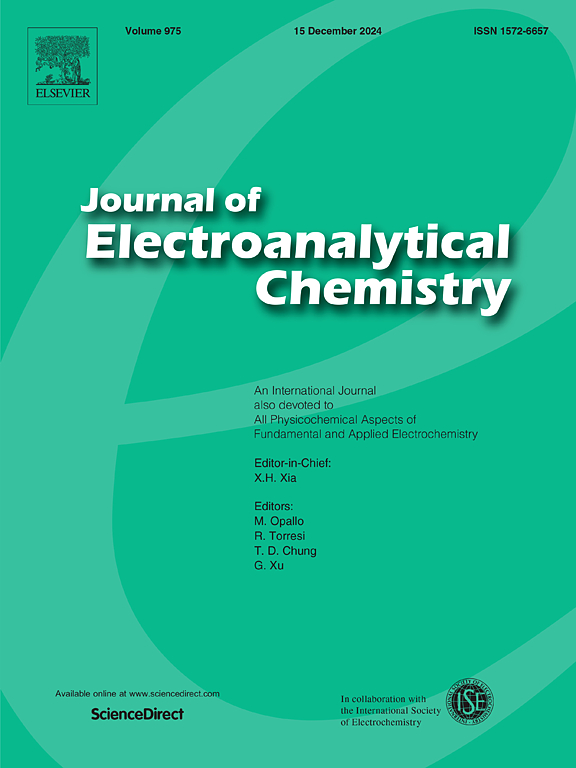具有可打印液体GaInZn合金阳极的柔性锌离子混合超级电容器
IF 4.1
3区 化学
Q1 CHEMISTRY, ANALYTICAL
引用次数: 0
摘要
在可穿戴电子领域,柔性储能的进步关键取决于高效电极的创新。然而,锌离子混合超级电容器(zihsc)中使用的传统锌阳极具有有限的柔韧性。在这项研究中,我们制作了一种新型的GaInZn合金阳极。通过精确熔化Ga, In和Zn的精确比例,随后通过印刷技术沉积在柔性基板上。液体增益相以其独特的特性均匀地涂覆在阳极表面,从而优化了局部电场和离子电流分布,有效地抑制了锌枝晶的生长。由于其相对较低的熔点,便于在柔性基板上的应用。组装的GaInZn//PAM//AC器件具有质量比为mGa/mIn/mZn = 3/5.6/1.4的合金,表现出优异的性能,在3000次循环后保持88%的容量。它还提供了令人印象深刻的能量密度为54.5 Wh kg - 1,功率密度为287.2 W kg - 1。此外,反复的弯曲测试显示出优异的机械稳定性,即使在800次弯曲循环后,该装置仍保持其初始容量的80.8%。这种可打印的液态合金阳极在可穿戴电子产品领域的下一代柔性储能方面具有很大的前景。本文章由计算机程序翻译,如有差异,请以英文原文为准。

Flexible zinc-ion hybrid supercapacitors with printable liquid GaInZn alloy anode
In the realm of wearable electronics, the advancement of flexible energy storage hinges critically on the innovation of efficient electrodes. However, traditional zinc anodes employed in zinc-ion hybrid supercapacitors (ZIHSCs) exhibit restricted flexibility. In this study, we fabricated a novel GaInZn alloy anode. Through the precise melting of Ga, In, and Zn in exact proportions and subsequent deposition onto a flexible substrate via a printing technique. The liquid Ga![]() In phase, with its unique characteristics, uniformly coats the anode surface, thereby optimizing the local electric field and ion current distribution and effectively inhibiting the growth of zinc dendrites. Facilitated by its relatively low melting point, the application onto the flexible substrate is facilitated. The assembled GaInZn//PAM//AC device, featuring an alloy with a mass ratio of mGa/mIn/mZn = 3/5.6/1.4, demonstrated exceptional performance, achieving 88 % capacity retention after 3000 cycles. It also delivered an impressive energy density of 54.5 Wh kg−1 at a power density of 287.2 W kg−1. Moreover, repeated bending tests revealed excellent mechanical stability, with the device retaining 80.8 % of its initial capacity even after 800 bending cycles. This printable liquid alloy anode holds substantial promise for the next-generation flexible energy storage within the realm of wearable electronics.
In phase, with its unique characteristics, uniformly coats the anode surface, thereby optimizing the local electric field and ion current distribution and effectively inhibiting the growth of zinc dendrites. Facilitated by its relatively low melting point, the application onto the flexible substrate is facilitated. The assembled GaInZn//PAM//AC device, featuring an alloy with a mass ratio of mGa/mIn/mZn = 3/5.6/1.4, demonstrated exceptional performance, achieving 88 % capacity retention after 3000 cycles. It also delivered an impressive energy density of 54.5 Wh kg−1 at a power density of 287.2 W kg−1. Moreover, repeated bending tests revealed excellent mechanical stability, with the device retaining 80.8 % of its initial capacity even after 800 bending cycles. This printable liquid alloy anode holds substantial promise for the next-generation flexible energy storage within the realm of wearable electronics.
求助全文
通过发布文献求助,成功后即可免费获取论文全文。
去求助
来源期刊
CiteScore
7.80
自引率
6.70%
发文量
912
审稿时长
2.4 months
期刊介绍:
The Journal of Electroanalytical Chemistry is the foremost international journal devoted to the interdisciplinary subject of electrochemistry in all its aspects, theoretical as well as applied.
Electrochemistry is a wide ranging area that is in a state of continuous evolution. Rather than compiling a long list of topics covered by the Journal, the editors would like to draw particular attention to the key issues of novelty, topicality and quality. Papers should present new and interesting electrochemical science in a way that is accessible to the reader. The presentation and discussion should be at a level that is consistent with the international status of the Journal. Reports describing the application of well-established techniques to problems that are essentially technical will not be accepted. Similarly, papers that report observations but fail to provide adequate interpretation will be rejected by the Editors. Papers dealing with technical electrochemistry should be submitted to other specialist journals unless the authors can show that their work provides substantially new insights into electrochemical processes.

 求助内容:
求助内容: 应助结果提醒方式:
应助结果提醒方式:


